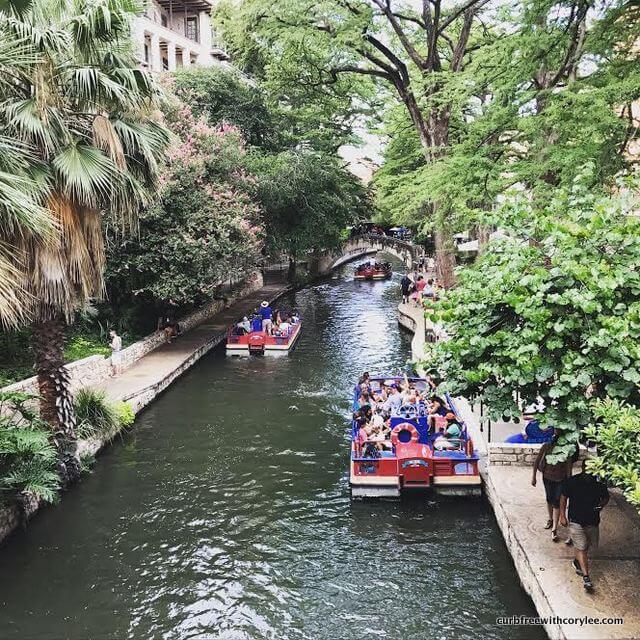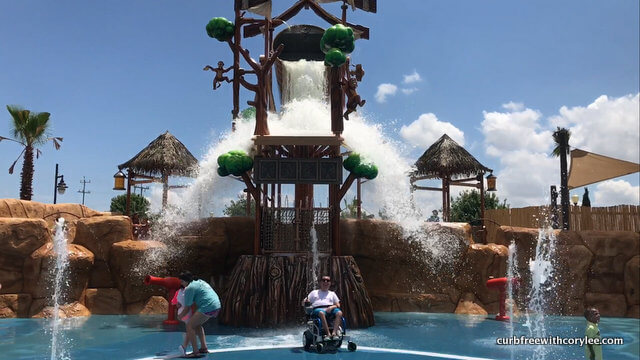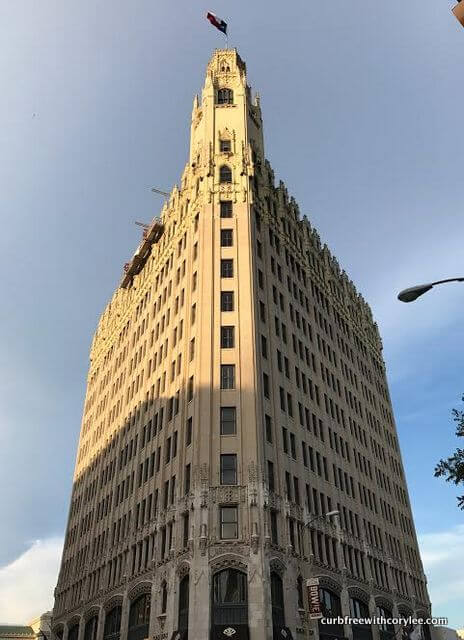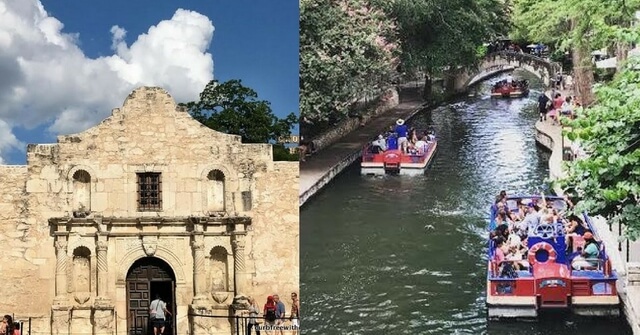San Antonio, Texas is a popular tourist destination, known as the home of the Alamo, the famous Emily Morgan Hotel and the scenic River Walk. I visited San Antonio for the first time this summer and learned firsthand that it is an excellent destination for those with mobility impairments. The city began greatly increasing its wheelchair accessibility during the 1980s, and continues to make upgrades such as building more accessible pathways and eliminating barriers. Over the years, San Antonio has upgraded forty locations with new ramps, pathways, and elevators. I highly recommend a visit to this colorful and historic city, which offers many options for wheelchair users. Here’s what you need to know before visiting San Antonio –
Best Things to Do in San Antonio
1. The Alamo

Founded in 1793 as a Catholic mission and fortress, this was the location of the 1836 Battle of the Alamo. It is now a museum and designated UNESCO World Heritage site. All public areas are accessible, though some of the monuments may present difficulties. There are ADA-compliant bathrooms and water fountains at the back of the grounds located near the covered arbor. The flagstone floors are uneven in some areas and the church has only one accessible entrance at the front door. Staff are available to assist if needed and wheelchairs can be checked out at the church. There is no fee, but visitors are required to leave an ID or license until the wheelchair is returned.

Before touring the Alamo, I highly recommend going first to see the Alamo IMAX movie. You can see the movie at the theater inside the Rivercenter Mall, which is located next door to the Alamo. The wraparound screen is six stories high and eighty-three feet wide and the movie itself provides historical background and context of the Battle of the Alamo. The theater has wheelchair ramps, is ADA-compliant and provides accessible seating for patrons in wheelchairs.
2. The River Walk

This famous attraction consists of a series of walkways that follow the San Antonio River for approximately five miles. Many bars, restaurants, stores and art installations are situated along these scenic walkways. The downtown river loop is the oldest section of the River Walk and many access points in this area have stairs only. Many parts of the walkway do not have safety railings so caution is essential. However, about 75% of the River Walk is accessible and there are many places where a person with a mobility impairment can enter. The northern section of the River Walk is far newer and all the bridges are accessible with every entrance featuring ramps. One of the best entry points is the Hyatt Regency at 123 Losoya Street, which offers elevator access down to the River Walk.

Enjoying a cruise with Rio San Antonio Cruises
The famous river tours provided by Rio San Antonio Cruises are highly recommended and all boarding locations are ADA-accessible. This was my absolute favorite thing at the River Walk. Each barge can accommodate two wheelchairs and wheelchair seating can be found next to the passenger boarding area. River tours are 35 minutes and provide a history of the River Walk. Dinner cruises and private tours can also be booked on these accessible boats.
3. Morgan’s Wonderland

Boarding the Whirling Wonder ferris wheel
This fully accessible theme park extends over a spacious twenty-five acres and is the first of its kind in the world. It was built by home developer Gordon Hartman in honor of his daughter Morgan, who has various cognitive impairments. All of the rides and attractions are adapted to accommodate visitors with mobility impairments. Some of the notable rides include the Wonderland Express Train, the Off-Road Adventure and the Whirling Wonder Ferris Wheel. The park features playgrounds such as the Butterfly Playground and Pirate Island Playground, picnic areas, gardens and many outdoor recreational activities such as shows. Admission is free for those with special needs. The spacious restrooms have heating and air-conditioning and are ADA-accessible, though guests need to bring their own wheelchairs as the park does not rent them.
To read my full article all about Morgan’s Wonderland, just click here.
4. Morgan’s Inspiration Island

The recently opened Morgan’s Inspiration Island is the world’s first ultra-accessible splash park. It features elaborate water fountains and sprinklers and is the perfect place to cool down on a hot day. The park has a variety of “splash pads” such as Calypso Cove, with its large tropical tree and rain curtain, and the surf-themed Hang Ten Harbor with a water wave. There is even a warmer water Rainbow Reef pad for visitors who cannot tolerate cold water temperatures. Another attraction is the River Boat Adventure Ride, a five minute boat ride through a jungle scene. There are park attendants supervising all water attractions and since there are no swimming pools, there are no lifeguards on duty. The splash park is open daily during the summer and on weekends in mid-August and September. Since the park’s capacity is limited, tickets should be purchased in advance online. All visitors with special needs can visit free of charge. Amenities include seven accessible changing rooms with adult-sized changing tables as well as four standard changing rooms for those who can change without assistance. Two of the accessible rooms also have Hoyer lifts. All of the changing rooms are located near the entrance to Morgan’s Inspiration Island. Visitors in wheelchairs should use the park’s specially designed waterproof wheelchairs, which are available on a first-come first-serve basis.
To read my full article all about Morgan’s Inspiration Island, just click here.
5. San Antonio Museum of Art

This famous art museum is located along the northern section of the River Walk and features extensive collections of Latin American, Asian, ancient Mediterranean and Contemporary art. Current exhibitions include: The Magic of Clay and Fire, Japanese Contemporary Ceramics and Carlos Merida. The museum is fully accessible with ramps, elevators and ADA-compliant restrooms. Wheelchairs may be requested from a security guard at the front desk at the time of your visit and are available on a limited first-come, first-served basis. Service animals are welcome in the museum.
Wheelchair Transportation San Antonio
The overall accessibility of the River Walk makes travel through the city much easier for visitors in wheelchairs. There are elevators at several points and the majority of the entrances have ramps. In general, most city sidewalks slope down to the curb at intersections, which makes crossing streets relatively easy.

For longer trips, San Antonio has several taxi companies with accessible cabs. These include Yellow Cabs and San Antonio Wheelchair Taxi. Yellow Cab accessible taxis feature lowered floor entry access and passengers with wheelchairs measuring 31 inches or less do not need to transfer out of their wheelchair. Fares are the same as those for standard taxis and three additional people can ride at no extra charge. When booking a ride, wheelchair users simply need to request an accessible cab. San Antonio Wheelchair Taxi states that their services are in high demand and recommend booking a cab as far in advance as possible. They allow up to four other people to ride in the cab for no additional charge. If a person with a mobility impairment is traveling alone, they will also escort him or her to and from the vehicle.
Besides the taxis, there are VIA trolleys to transport visitors to most of the major tourist destinations and these are completely accessible. The Alamo Trolley offers narrated tours of the city but these are less accessible. Wheelchair users need to contact them 24 hours in advance to request a lift and can only board and exit at the Visitor Center. Accessible River Taxis are also available for trips along the river.
Where to Stay: The Emily Morgan Hotel reviews

The Emily Morgan Hotel is a famous San Antonio landmark, is located downtown two blocks from the River Walk and features fantastic views of the Alamo. The building was constructed in 1924 and was originally used as a medical complex. For some years it was widely considered to be the most advanced hospital west of the Mississippi. The building was renovated in 1976 and used for corporate offices but was then converted into a hotel in 1986. Standing thirteen stories high, the architecture is Gothic revival and gargoyles depicting different medical conditions perch on the sides of the building. Centrally located, the hotel is a short distance away from a variety of bars and great San Antonio restaurants.

On the left is The Emily Morgan Hotel and on the right is the Alamo
The hotel was extensively renovated in 2012, when its management was taken over by DoubleTree. The hotel features a number of accessible rooms, falling into two separate categories. The Standard Mobility/Hearing Accessible guest rooms are more cost-effective, include one king bed or two double beds and each room has a roll-in shower or tub and sensor systems. The Mobility/Hearing Accessible Deluxe Suites are more spacious and include an accessible tub.

There’s also a pool lift for wheelchair users
The hotel is also known for the considerable amount of folklore surrounding it. The building is named after a folk heroine who according to legend, distracted General Santa Ana during the battle of San Jacinto. This legend is the source of the story of the Yellow Rose of Texas. The name Emily Morgan is actually inaccurate, as the real name of the woman the legend was based on was Emily D. West. There are numerous reports of paranormal activity at the Emily Morgan Hotel, which likely stem from the building’s dramatic Gothic architecture, its past as a hospital and its proximity to the Alamo, where the historic battle took place.
Check prices at The Emily Morgan Hotel by clicking here.
I was pleasantly surprised to find that San Antonio, Texas is a highly accessible city that is committed to continuing progress in this area. The majority of the famous tourist attractions can be easily visited by wheelchair users, and there are extensive transportation options as well. San Antonio also bears the distinction of having the world’s first fully accessible theme park, Morgan’s Wonderland, which is an incredible family-friendly place. I highly recommend a visit to this beautiful city with its rich history, scenic views and very accessible hotels and tourist sites.
*This post includes affiliate links. When you click on a link, I may receive a small compensation, which will help this blog grow into a better resource for disabled travelers.







